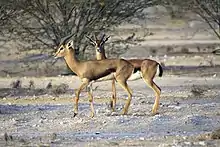Arabian gazelle
The Arabian gazelle (Gazella arabica) is a species of gazelle from the Arabian Peninsula.
| Arabian gazelle | |
|---|---|
_Gazella_arabica.png.webp) | |
| Scientific classification | |
| Kingdom: | Animalia |
| Phylum: | Chordata |
| Class: | Mammalia |
| Order: | Artiodactyla |
| Family: | Bovidae |
| Subfamily: | Antilopinae |
| Genus: | Gazella |
| Species: | G. arabica |
| Binomial name | |
| Gazella arabica Lichestein, 1827 | |
| Synonyms | |
| |
Taxonomy
Until recently, it was only known from a single lectotype specimen mistakenly thought to have been collected on the Farasan Islands in the Red Sea in 1825. A 2013 genetic study of the lectotype specimen revealed that skull and skin do not stem from the same individual but belong to two distinct lineages of the mountain gazelle (Gazella gazella), necessitating restriction of the lectotype to the skin to conserve nomenclatural stability. A later study formalized the use of Gazella arabica for the Arabian lineage of the mountain gazelle, and synonymized Gazella erlangeri with G. arabica.[2][3]

Conservation
The Arabian gazelle is classified as a vulnerable species. There are many environmental factors affecting the population density of Arabian gazelles, such as human hunting, predation, competition, and climate change. The decline in population is due to human disturbances such as construction and illegal hunting. Other factors include temperature change, and predation (mainly by wolves); as the researchers stated in their findings that, “Wolf encounter rate had a significant negative effect on G. arabica population size, while G. dorcas population size had a significant positive effect, suggesting that wolf predation shapes the population size of both gazelle species (Shalmon, B., Sun, P. & Wronski, T., 2020). [4] [5]
References
- https://www.iucnredlist.org/species/117582065/88018124 IUCN SSC Antelope Specialist Group 2017. Gazella arabica. The IUCN Red List of Threatened Species 2017: e.T117582065A88018124. doi:10.2305/IUCN.UK.2017-2.RLTS.T117582065A88018124.en. Downloaded on 9 November 2019.
- Bärmann EV, Börner S, Erpenbeck D, Rössner GE, Hebel C, Wörheide G (2013). "The curious case of Gazella arabica". Mammalian Biology. 78 (3): 220–225. doi:10.1016/j.mambio.2012.07.003.
- Bärmann, E. V., Wronski, T., Lerp, H., Azanza, B., Börner, S., Erpenbeck, D., Rössner, G. E. and Wörheide, G. (2013), A morphometric and genetic framework for the genus Gazella de Blainville, 1816 (Ruminantia: Bovidae) with special focus on Arabian and Levantine mountain gazelles. Zoological Journal of the Linnean Society, 169: 673–696. doi: 10.1111/zoj.12066
- http://apps.webofknowledge.com/full_record.do?product=WOS&search_mode=GeneralSearch&qid=23&SID=5AYg1Uqqiusm1vVugRr&page=1&doc=10
- http://apps.webofknowledge.com/full_record.do?product=WOS&search_mode=GeneralSearch&qid=19&SID=5AYg1Uqqiusm1vVugRr&page=1&doc=2
- Shalmon, B., Sun, P. & Wronski, T. Factors driving Arabian gazelles (Gazella arabica) in Israel to extinction: time series analysis of population size and juvenile survival in an unexploited population. Biodivers Conserv 29, 315–332 (2020). https://doi.org/10.1007/s10531-019-01884-8
